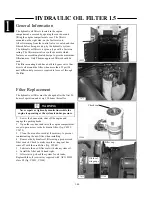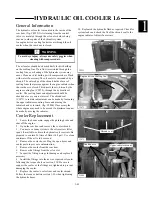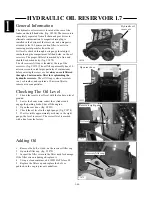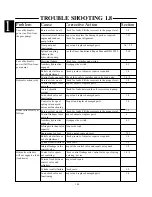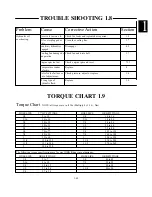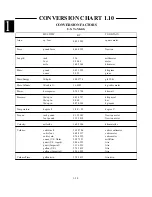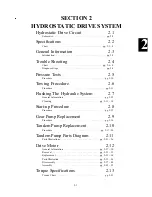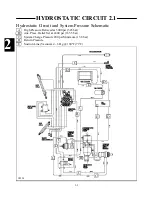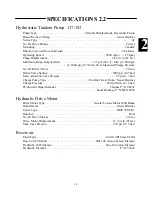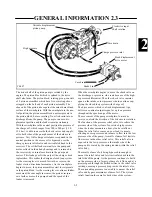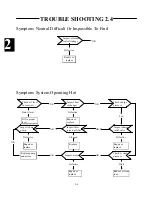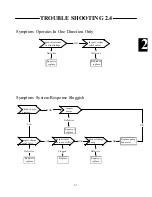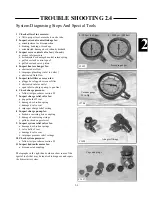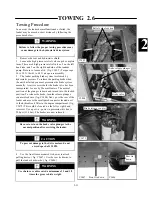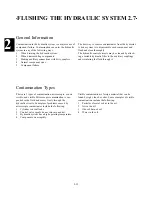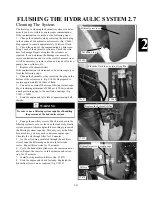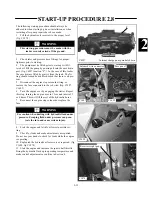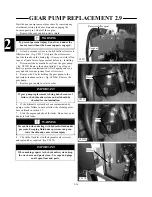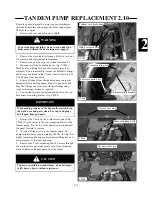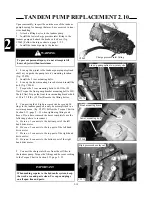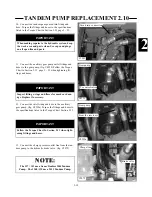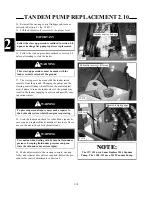
2-5
2
The drive shaft of the piston pump is rotated by the
engine. The piston block which is splined to the drive
shaft also turns. The piston block, rotating group, consists
of 9 piston assemblies which have free swiveling shoes
swagged on the ball end of each piston assembly. The
shoe end of the piston rides against the smooth machined
surface of the swashplate. With the swashplate in the neu-
tral position, the piston assemblies do not reciprocate in
the piston block, but are rotating. No oil is drawn into or
discharged from the pump. The pump is in a zero dis-
placement position and the loader remains stationary.
With the swashplate in the neutral position the pressure of
the charge oil, which ranges from 200 to 280 psi (13.8 -
19.3 bar), is able to unseat both check valves and supply
oil to both sides of the pump because of the balance in
pressure. Very little charge oil volume is required in the
neutral position so the excess oil is bypassed over the
charge pressure relief valve and recirculated back to the
reservoir. The oil that leaks internally in the pump and
motor collects in their body housings and is returned to
the reservoir by external case drain in the pump and
motors. This leakage oil is the only oil the charge check
replenishes. This makes the design a closed loop system.
As the steering lever is moved forward, or reverse, the
loader starts a directional movement. As the swashplate
begins to move, the piston assemblies start to reciprocate
in the piston block. As the steering lever continues further
movement the cam angle increases, the pistons recipro-
cate further, more oil is pumped and the speed of the
loader is increased.
The drive motor, which is a fixed displacement type,
delivers a constant output torque for a given pressure
throughout the speed range of the motor.
The movement of the pump swashplate, forward or
reverse, controls the direction of the drive motor rotation.
The function of the pressure relief valve is to relieve the
pressure side of the system of excessive high pressure
when the loader encounters a heavy load or stalls out.
When the relief valve senses an over load it unseats,
allowing excess pressure and volume to flow into the low
pressure side of the pump. A small volume of oil starts to
flow across to the other relief valve. This relief valve is
exposed to the low pressure on the intake side of the
pump and is seated by the spring tension within the relief
valve body.
The small volume of oil being bypassed is enough to
unseat the relief valve and let it recirculate back into the
inlet side of the pump. As the pressure continues to build
on the pressure side, a larger volume of oil flows and at a
greater speed through the drilled orifice in the relief valve
cartridge, causing a pressure drop inside the relief valve.
The surrounding pressure is now able to unseat the relief
valve and bypass maximum volume of oil. The system
reliefs function the same for both sides of the system.
When the swashplate begins to move the check valve on
the discharge, or pressure, side seats because of the high-
er pressure differential. The other check valve remains
open on the intake or low pressure side to continue sup-
plying the closed loop system with charge oil.
C4447
Clockwise input
shaft rotation
High pressure
Case drain
Case drain
Charge pressure inlet
Fixed displacement
drive motor
Variable displacement
piston pump
GENERAL INFORMATION 2.3
Brake Line



